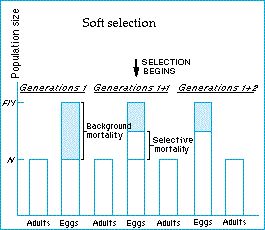Hard & soft selection

When natural selection is operating on a population, individuals with some genotypes are more likely to die, or fail to reproduce, than individuals with other genotypes. The death, or non-reproduction, needed for selection may be hard or soft.
Hard selectionWhen natural selection is actually substituting one gene for another, it does so by means of extra mortality, on top of the background mortality which exists anyway. This is called hard selection. If selection requires extra mortality, it will tend to depress the population size. The rate of evolution, therefore, has an upper limit: if selection is too strong it will depress the population size to zero.
Soft selectionUnder soft selection, the selective deaths are substituted for non-selective background mortality. If all the mortality suffered by a population was selective, evolution could proceed at an immense speed.
Hard and soft selection are extremes of a continuum and in practice, natural selection in different cases could be any mixture of hard and soft selection.
Haldane's theory of the cost of natural selection assumed that selection is hard. There has to be selective death (or non-reproduction) for evolution by natural selection. But Haldane's use of the concept, to calculate an upper limit on the rate of evolution, assumed that selection is quite hard. He assumed only 10% selective non-reproduction could be endured.
There is considerable upside in the rate of evolution if selection is softer than Haldane assumed and the neutral theory is weakened.
The distinction between hard and soft selection matters in interpreting genetic loads.
Figure: a population with N adults of average fecundity 2F per female, produces FN eggs. By the ordinary ecological processes of mortality, if the population size is constant, the FN eggs must be reduced to N adults. FN - N of the eggs die before reproducing. In the extreme of soft selection shown opposite, all selective mortality replaces some of the background ecological mortality and the population size is not altered by selection operating.
| Next |



